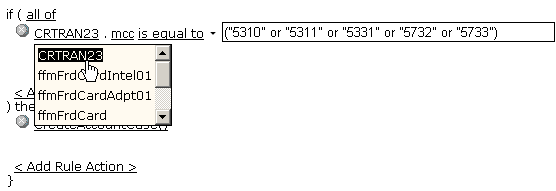Data Feed Objects and Custom UDFs
Data feed objects have properties that correspond to the incoming transaction data using either standard transaction data feed data or custom UDFs.
Each data feed defines the transaction data that is sent to Falcon. There is a separate project and ruleset for each data feed. When you add or edit a rule in the ruleset for a particular data feed, you have access to an object that defines all of the properties relating to that data feed. Typically, you access those properties in your rule conditions.
For example, if you use the Credit 2.5 Authorization-Posting data feed, you have a project of the same name that contains a ruleset called Decision Ruleset. If you add or edit a rule in the ruleset you have access to an object called CRTRAN25 (or CRTRAN23 for an older version).

Once you select the object, you have access to all of the properties of that object.

Data feeds objects can be extensive, holding a large number of properties. It is important to work with your System Administrator to determine exactly which fields are being populated by your organization.
Custom user-defined fields offer an extension of existing Falcon feed definitions. If your organization has defined custom UDFs, those fields are available for rule writing. For example, if you use the Credit 2.5 Authorization-Posting data feed, you have a project of the same name that contains a ruleset called Decision Ruleset. If you add or edit a rule in the ruleset you have access to an object called CUSTOM_CRTRAN25, which provides access to all custom UDFs associated with CRTRAN25, if they have been created.
 | See Also: Information about the process for defining custom user-defined fields can be found in "Generating Custom UDF Files" in the
FICO®
Falcon® Fraud Manager Case Manager and Expert Installation Guide.
|